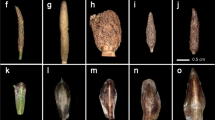Abstract
To investigate the origin of the triploid agamosporous speciesD. yakusilvicola, an electrophoretic analysis was made for five enzymes of theD. sparsa complex.Dryopteris yakusilvicola showed a monomorphic banding pattern for the five enzymes and was heterozygous in all six gene loci coding them. Comparison of enzyme banding patterns suggests that the genome ofD. yakusilvicola was derived through hybridization betweenD. sabaei and either a sexual tetraploid or an agamosporous triploid ofD. sparsa. Cytological evidence (Darnaediet al., 1989) supports the idea that of the two types ofD. sparsa the sexual tetraploid is a parent. The monomorphic pattern implies thatD. yakusilvicola originated from a single hybrid between the parental species, and that it is a neo-endemic of Yakushima Island.
Similar content being viewed by others
References
Darnaedi, D. andK. Iwatsuki. 1987. On the structure and systematic position of the fernDryopteris yakusilvicola Kurata. J. Fac. Sci. Univ. Tokyo III.14: 121–136.
—,M. Kato andK. Iwatsuki. 1989. A cytotaxonomic study ofDryopteris sparsa and closely related species (Dryopteridaceae). J. Jap. Bot.64: 330–340.
Fraser-Jenkins, C.R. 1986. A classification of the genusDryopteris (Pteridophyta: Dryopteridaceae). bull. Brit. Mus. (Nat. Hist.) Bot.14: 183–218.
Gastony, G.J. 1986. Electrophoretic evidence for the origin of fern species by unreduced spores. Amer. J. Bot.73: 1563–1569.
— 1988. ThePellaea glabella complex: electrophoretic evidence for the derivations of the agamosporous taxa and a revised taxonomy. Amer. Fern J.78 44–67.
— andD.C. Darrow. 1983. Chloroplastic and cytosolic isozymes of the homosporous fernAthyrium filix-femina L. Amer. J. Bot.70: 1409–1415.
— andL.D. Gottlieb. 1985. Genetic variation in the homosporous fernPellaea andromedifolia. Amer. J. Bot.72: 257–267.
Gottlieb, L.D. 1982. Conservation and duplication of isozyme in plants. Science216: 373–380.
— 1987. Phosphoglucomutase and isocitrate dehydrogenase gene duplication inLayia (Compositae). Amer. J. Bot.74: 9–15.
Grant, V. 1981. Plant Speciation. Columbia Univ. Press New York.
Haufler, C.H. 1987. Electrophoresis is modifying our concepts of evolution in homosporus pteridophytes. Amer. J. Bot.74: 953–966.
—,M.D. Windham, D.M. Briton andS.J. Robinson. 1985. Triploidy and its evolutionary significance inCystopteris protrusa. Canad. J. Bot.63: 1855–1863.
Hirabayashi, H. 1967. Chromosome numbers in Japanese species ofDryopteris. J. Jap. Bot.42: 44–48.
— 1974. Cytogeographic Study onDryopteris of Japan. Hara-Shobo, Tokyo
Imaichi, R., D. Darnaedi andM. Kato. 1987. Adventitious buds ofDryopteris sparsa complex (Dryopteridaceae): developmental anatomy and systematic implication. Bot. Mag. Tokyo100: 365–372.
Klekowski, E.J., Jr. 1973. Sexual and subsexual system in homosporous pteridophytes: a new hypothesis. Amer. J. Bot.60: 535–544.
Kurata, S. 1967. Notes on Japanese ferns (41). J. Geobot.15: 83–85.
Lellinger, D.B. 1985. A Field Manual of the Ferns & Fern Allies of the United States & Canada. Smithsonian Inst. Press. Washington, D.C.
Lovis, J.D. 1977. Evolutionary patterns and processes in ferns.In R.D. Preston and H.W. Woolhouse, ed., Advances in botanical Research, Vol. 4, pp. 229–415. Academic Press, London.
Mitui, K. 1982. Spore Morphology of Japanese Ferns. Hojo-Shokan, Tokyo. (in Japanese).
Morzenti, V.M. 1962. A first report on pseudomeiotic sporogenesis, a type of spore reproduction by which “sterile” ferns produce gametophytes. Amer. Fern J.52: 69–78.
Richards, A.J. 1970. Eutriploid facltative agamospermy inTaraxacum. New Phytol.69: 761–774.
Serizawa, S. 1971. Two new varieties of Japanese ferns. J. Geobot.19: 103–104 (in Japanese with English summary).
Soltis, D.E., C.H. Haufler, D.C. Darrow andG.J. Gastony. 1983. Starch gel electrophoresis of ferns: a complication of grinding buffers, gel and electrode buffers, and staining schedules. Amer. Fern J.73: 9–27.
Walker, T.G. 1962. Cytology and evolution in the fern genusPteris L. Evolution16: 27–43.
Watano, Y. andK. Iwatsuki. 1988. Genetic variation in the ‘Japanese apogamous form’ of the fernAsplenium unilaterale Lam. Bot. Mag. Tokyo101: 213–222.
Author information
Authors and Affiliations
Rights and permissions
About this article
Cite this article
Darnaedi, D., Kato, M. & Iwatsuki, K. Electrophoretic evidence for the origin ofDryopteris yakusilvicola (Dryopteridaceae). Bot. Mag. Tokyo 103, 1–10 (1990). https://doi.org/10.1007/BF02488406
Received:
Accepted:
Issue Date:
DOI: https://doi.org/10.1007/BF02488406




